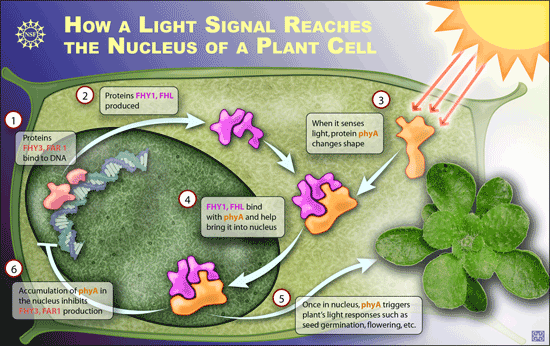Washington, DC
November 23, 2007
Plants prepare to respond to
light while still in the dark
Most of us take it for granted
that plants respond to light by growing, flowering and straining
towards the light, and we never wonder just how plants manage to
do so. But the ordinary, everyday responses of plants to light
are deceptively complex, and much about them has long stumped
scientists.
Now, a new study "has significantly advanced our understanding
of how plant responses to light are regulated, and perhaps even
how such responses evolved," says Michael Mishkind, a program
director at the National Science
Foundation (NSF). This study, which was funded by NSF, will
be published in the November 23, 2007 issue of Science.
 |
|
Two
proteins known as FHY3 and FAR1 bind to DNA in a
plant cell and cause production of two other
proteins known as FHY1 and FHL. When hit with far
red light, a light-sensitive protein called
phytochrome A (phyA) changes its shape. This shape
change allows it to bind to FHY1 and FHL. FHY1 and
FHL then carry the activated phyA into the cell
nucleus. From there, phyA is able to initiate the
plant's developmental responses to light such as
growth, flowering and straining towards the light.
Credit: Zina Deretsky, National Science Foundation |
By conducting experiments with
Arabidopsis--a small flowering plant widely used as a model
organism--the researchers discovered that the plant prepares to
respond to light while it is still in the dark, even before it
is exposed to light. This preparation involves producing a pair
of closely related proteins (known as FHY3 and FAR1) that
increase production of another pair of closely related proteins
(known as FHY1 and FHL) that had been identified in previous
studies as critical participants in the plant's light response.
Haiyang Wang, a member of the research team from
Boyce Thompson
Institute for Plant Research, says that the plant probably
stockpiles these proteins needed for light responses in the dark
for the same reason that a traveler fills his car's gas tank the
night before a morning journey: in order to be able to get
going, without delay, at first light.
 |
|
This
image shows micrographs of plant roots. The green dots
inside indicate presence of the FHY3 protein in the
cells' nuclei. Notice the protein has accumulated in the
division zone of the primary root. The artists have
added computational models in the middle showing FHY3
protein (in green) binding to DNA (shown in gray).
Researchers have discovered that FHY3 and FAR1, two
proteins derived from what are called "jumping genes",
put into motion the sequence of events that bring about
the light responses of a plant such as growth, flowering
and straining towards light.
Credit: Pelkie, Daniel Ripoll, and Rongcheng Lin |
With a plant so primed in the
dark, it detects and responds to light via the following steps:
- Light-sensing pigment
proteins known as phytochrome A located in the cytoplasm of
plants cells detect the light in the far-red end of the
spectrum.
- The phytochrome A is
activated through a change in shape that allows it to bind
to FHY1 and FHL. The binding of FHY1 and FHL to phytochrome
A results in the accumulation of phytochrome A in the cell
nucleus, possibly by helping to import phytochrome A into
the nucleus.
- The activated phytochrome
A changes the activity of genes located in the cell nucleus
that govern plant growth and development.
- Resulting changes in gene
expression produce the plant's developmental responses to
light, such as growth, flowering and straining towards the
light.
Although these steps had
been identified in previous studies, the discovery of how
FHY3 and FAR1 regulate plant responses to light adds an
important new dimension to our understanding of them.
Moreover, the researchers also discovered the existence of a
negative feedback loop between accumulations of phytochrome
A in the cell nucleus and the FHY3 and FAR1 proteins that
prime the plant's light response system: the more
phytochrome A accumulates in the nucleus, the less FHY3 and
FAR1 proteins are produced, and so less phytochrome A is
imported into the nucleus. "This feedback loop serves as a
built-in brake that limits the flow of light responses,"
says Wang.
"I can't explain why nature created such a complex process
to trigger a plant's light responses," says Wang with a
sigh. Among the process's complexities is a resemblance
between FHY3 and FAR1 proteins and certain enzymes produced
by some mobile DNA elements or so-called "jumping genes."
(Jumping genes are so named because they can move between
various positions in a cell's genetic code.) "This
resemblance initially puzzled the research team when we were
trying to identify the molecular function of the proteins,"
says Wang.
Nevertheless, the resemblance between the FHY3 and FAR1
proteins and jumping gene enzymes may represent a biological
blessing in disguise. Why? Because the researchers now
believe that they have built a convincing case that FHY3 and
FAR1 may have evolved from the jumping gene material. If
indeed the proteins did so, this important chapter in
evolution may have helped make possible the establishment of
flowering plants on earth, says Wang. |
|